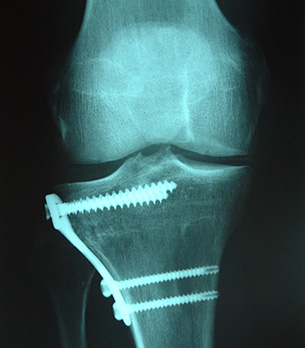
Metalwork implanted into a tibia at tibial osteotomy, a realignment procedure for early osteoarthritis of the knee and an alternative to total knee replacement.
Most diseases and injuries of the human body can be treated in more than one way. The knee joint is no exception.
This section covers the following topics: |
||||
|
|
|||
|
|
|||
|
|
|||
|
|
|
||
|
|
|
||
Alternative Therapies
The title 'alternative' medicine is difficult to define. For practitioners who adopt such methods, and to their patients, it is mainstream. Nevertheless, treatments such as aromatherapy, reflexology, magnetotherapy, homeopathy, acupuncture, even osteopathy and diet have all at times been considered alternative therapies. Each has a part to play in managing knee conditions.
Physiotherapy
Physiotherapy is of major use in the management of knee conditions at all ages. Muscular control is particularly important in knee function and physiotherapy ("physio") can build up the strength of such muscles. It can even concentrate on specific muscle groups for specific knee conditions. For example, with patellar (kneecap) dislocation, the patella dislocates laterally (outwardly). By building up the muscles on the medial (inner) aspect of the knee joint, particularly one known as vastus medialis, the lateral shift of the patella can be counteracted. Ultrasound, laser treatment, manipulation and many other techniques in the physiotherapist's repertoire make a major contribution to the management of knee problems.
Medication
Medication may be required for the management of the injured or diseased knee. Usually this will take the form of:
1. Painkillers (analgesics)
2. Non-steroidal anti-inflammatories (NSAIDs)
3. Injection
4. Steroids
Steroids, the final group, are not without hazard and should only be used under strictly controlled circumstances. Injections usually involve steroids (hydrocortisone or triamcinolone) and should therefore be administered with care. Hyaluronic acid injections are also possible, a process known as viscosupplementation. This may involve a sequence of injections, or a single, depot injection. In some centres the results of viscosupplementation have been good, in others the effects have been less predictable.
Braces
Braces can provide knee support and are available in many shapes and sizes. There are three different types:
1. Functional
2. Rehabilitative
3. Prophylactic
Functional braces are usually given to patients with anterior cruciate ligament (ACL) damage, or to those who have had previous ACL reconstructive surgery. Rehabilitative braces are given to those who have recently undergone ligament repair. Prophylactic braces are designed to prevent knee injuries, or to reduce their severity should they occur. Some studies have been performed that encourage brace use, while others have found that people wearing braces can increase the risk of injuring the knee during sport. For anterior knee pain a small strap can sometimes be worn around the knee, just below the patella This is the infrapatellar brace, although its true mechanism of action is unclear.
SURGERY
Although it makes good sense to avoid an operation for as long as possible, once conservative treatment fails, surgery is the next step. Perhaps the two commonest operations performed in the developed world are arthroscopy and joint replacement. However, as well as these there are many other operations available for knee conditions. Many were performed in large numbers in earlier times and have now been abandoned. Others are still frequently performed today.
Osteotomy
Osteotomy is the orthopaedic word for division of a bone. It can be applied to the shin bone (tibial osteotomy) or the thigh bone (femoral osteotomy). The bone is divided just above or below the joint margin, depending on the type of osteotomy selected, and a deformed knee is then realigned. In essence this is a surgical fracture, the aim being to realign a misaligned joint. In osteoarthritis (OA), for example, the knee typically deforms as a bow leg (genu varum). This can be corrected by a tibial osteotomy. Knock-knees (genu valgum) can also be seen with OA, but also after fracture and in rheumatoid arthritis (RA). For these conditions a femoral osteotomy can occasionally be useful.
Results for tibial osteotomy are fair, although not outstanding. When performed for OA approximately 75% of patients will notice pain relief for approximately five years. Ten years after surgery only 60% report satisfactory pain relief. Complications are also associated with the technique, sometimes as high as 30%.
Patellectomy
Patellectomy is the orthopaedic term for removal of the patella. It used to be undertaken very regularly in earlier years, often as a treatment for the very common anterior knee pain. Results were variable and the mechanical strength of the knee could be permanently reduced. The main reason for undertaking patellectomy now is for symptomatic OA of the patellofemoral joint. Success rates vary between 50% (or less) and 87%.
Transplantation
The term transplantation does not only apply to hearts, livers, lungs, and the like. Bone and gristle (articular cartilage) can also be transplanted. Transplanted bone is often referred to as an allograft, with donors being subjected to the same level of scrutiny for transmissible diseases as blood donors.
Arthrodesis
Arthrodesis is the surgical fusion of a joint and was commonly performed when tuberculosis (TB) and polio were rife. It also provides a solution for the failed knee replacement. However, if a knee is fused, extra strain can be taken up by the joints surrounding the knee. The ankles, hips, and even the spine must compensate for lack of movement at the knee. These areas can sometimes suffer as a result.
Debridement
Debridement describes a thorough surgical cleaning of a diseased area. The results of debridement are unpredictable, although some have reported 75% success at six years or more following surgery. It is best used for young, active patients who are not suitable for osteotomy or joint replacement.
Stabilisation
The knee relies heavily on ligaments, tendons and muscles for its stability. The two commonest occasions when a stabilisation procedure might be performed are:
1. Recurrent patellar dislocation
2. Ruptured ACL
Recurrent patellar dislocation
Few would advocate patellar stabilisation on the basis of one dislocation. However, once the event has occurred three or more times, stabilisation is often considered as the condition is then said to be recurrent. Stabilisation may take various forms:
a. Lateral release
This involves the division of soft tissues along the lateral (outer) side of the patella, effectively weakening the tissues laterally and thereby strengthening the soft tissues medially. The patella normally dislocates laterally, so a lateral release is designed to counteract this.
b. Tibial tubercle transposition
Here, the patellar tendon insertion is lifted off the tibia and moved downwards and medially slightly, again to counteract the lateral displacing force on the patella. Results are variable, but up to 20% of patients can have a poor result.
Ruptured ACL
The ACL can also be reconstructed. For the athlete in particular, a knee that gives way whenever it is subjected to a rotational force can be very debilitating. A whole science surrounds ACL reconstruction - entire meetings are sometimes dedicated to it. Reconstructive techniques fall into two groups:
1. Intra-articular reconstruction
2. Extra-articular reconstruction
Some surgeons use a combination of the two. Intra-articular reconstructions involve the insertion of some form of graft along the line of the torn ACL. This can be performed arthroscopically, or by means of open surgery. Graft materials might include Dacron, carbon fibre, allograft, tendon, and others. An extra-articular repair leaves the torn ACL well alone, but repositions certain muscles and tendons on the outer side of the knee so that they begin to mimic the function of the ACL within. A well-known example of such an extra-articular repair is the Macintosh operation.
ACL reconstruction is widely undertaken, and long-term results are very variable. Unfortunately, however well an ACL reconstruction is performed, it is very difficult to return an ACL-deficient knee to normal. ACL rupture frequently heralds the end of a once brilliant sporting career, or at least a readjustment in sporting interests.
Other Stabilisation Techniques
Many other types of stabilisation procedures exist for the knee joint. The PCL can be reconstructed, increasingly so in current times. Likewise the medial collateral ligament (MCL) and lateral collateral ligament (LCL).
Arthroscopy
Arthroscopy ('keyhole surgery') has revolutionised knee surgery, allowing accurate diagnosis and treatment. Surprisingly a surgeon achieves a better view through the arthroscope than through an open incision.
Joint Replacement
Knee joint replacement is now big business. In many countries more knees than hips are now being replaced. It is a hugely successful operation with results now approaching hip replacement. Knee replacement is covered in more detail elsewhere on this website.
